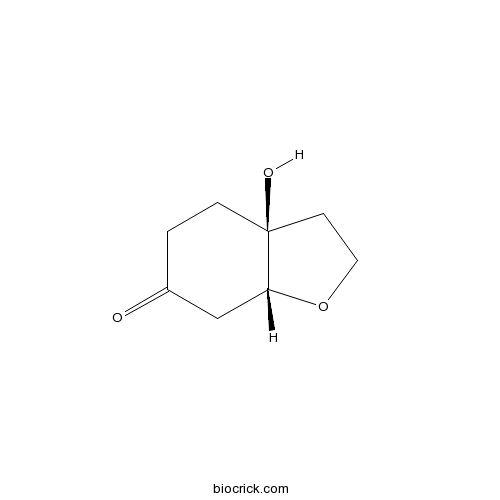Cleroindicin CCAS# 189264-44-6 |

Quality Control & MSDS
3D structure
Package In Stock
Number of papers citing our products

| Cas No. | 189264-44-6 | SDF | Download SDF |
| PubChem ID | 25199269 | Appearance | Oil |
| Formula | C8H12O3 | M.Wt | 156.2 |
| Type of Compound | Miscellaneous | Storage | Desiccate at -20°C |
| Synonyms | 183626-28-0 | ||
| Solubility | Soluble in Chloroform,Dichloromethane,Ethyl Acetate,DMSO,Acetone,etc. | ||
| Chemical Name | (3aS,7aR)-3a-hydroxy-2,3,4,5,7,7a-hexahydro-1-benzofuran-6-one | ||
| SMILES | C1CC2(CCOC2CC1=O)O | ||
| Standard InChIKey | ZCBQZDMJIVJQLX-SFYZADRCSA-N | ||
| Standard InChI | InChI=1S/C8H12O3/c9-6-1-2-8(10)3-4-11-7(8)5-6/h7,10H,1-5H2/t7-,8+/m1/s1 | ||
| General tips | For obtaining a higher solubility , please warm the tube at 37 ℃ and shake it in the ultrasonic bath for a while.Stock solution can be stored below -20℃ for several months. We recommend that you prepare and use the solution on the same day. However, if the test schedule requires, the stock solutions can be prepared in advance, and the stock solution must be sealed and stored below -20℃. In general, the stock solution can be kept for several months. Before use, we recommend that you leave the vial at room temperature for at least an hour before opening it. |
||
| About Packaging | 1. The packaging of the product may be reversed during transportation, cause the high purity compounds to adhere to the neck or cap of the vial.Take the vail out of its packaging and shake gently until the compounds fall to the bottom of the vial. 2. For liquid products, please centrifuge at 500xg to gather the liquid to the bottom of the vial. 3. Try to avoid loss or contamination during the experiment. |
||
| Shipping Condition | Packaging according to customer requirements(5mg, 10mg, 20mg and more). Ship via FedEx, DHL, UPS, EMS or other couriers with RT, or blue ice upon request. | ||
| Description | 1. Cleroindicin C has anticancer activity . |

Cleroindicin C Dilution Calculator

Cleroindicin C Molarity Calculator
| 1 mg | 5 mg | 10 mg | 20 mg | 25 mg | |
| 1 mM | 6.402 mL | 32.0102 mL | 64.0205 mL | 128.041 mL | 160.0512 mL |
| 5 mM | 1.2804 mL | 6.402 mL | 12.8041 mL | 25.6082 mL | 32.0102 mL |
| 10 mM | 0.6402 mL | 3.201 mL | 6.402 mL | 12.8041 mL | 16.0051 mL |
| 50 mM | 0.128 mL | 0.6402 mL | 1.2804 mL | 2.5608 mL | 3.201 mL |
| 100 mM | 0.064 mL | 0.3201 mL | 0.6402 mL | 1.2804 mL | 1.6005 mL |
| * Note: If you are in the process of experiment, it's necessary to make the dilution ratios of the samples. The dilution data above is only for reference. Normally, it's can get a better solubility within lower of Concentrations. | |||||

Calcutta University

University of Minnesota

University of Maryland School of Medicine

University of Illinois at Chicago

The Ohio State University

University of Zurich

Harvard University

Colorado State University

Auburn University

Yale University

Worcester Polytechnic Institute

Washington State University

Stanford University

University of Leipzig

Universidade da Beira Interior

The Institute of Cancer Research

Heidelberg University

University of Amsterdam

University of Auckland

TsingHua University

The University of Michigan

Miami University

DRURY University

Jilin University

Fudan University

Wuhan University

Sun Yat-sen University

Universite de Paris

Deemed University

Auckland University

The University of Tokyo

Korea University
- KU14R
Catalog No.:BCC1685
CAS No.:189224-48-4
- Helioxanthin
Catalog No.:BCC5413
CAS No.:18920-47-3
- Ro 48-8071 fumarate
Catalog No.:BCC5546
CAS No.:189197-69-1
- Tegaserod maleate
Catalog No.:BCC7955
CAS No.:189188-57-6
- Naringin dihydrochalcone
Catalog No.:BCN2579
CAS No.:18916-17-1
- 3'-O-Methylmurraol
Catalog No.:BCN7471
CAS No.:1891097-17-8
- Fas C- Terminal Tripeptide
Catalog No.:BCC1019
CAS No.:189109-90-8
- Bruceantinoside C
Catalog No.:BCN1166
CAS No.:112899-35-1
- Salmefamol
Catalog No.:BCC1919
CAS No.:18910-65-1
- Hulupinic acid
Catalog No.:BCN8019
CAS No.:1891-42-5
- Oroselol
Catalog No.:BCN3907
CAS No.:1891-25-4
- [Ala92]-p16 (84-103)
Catalog No.:BCC5837
CAS No.:189064-08-2
- Cleroindicin D
Catalog No.:BCN1168
CAS No.:189264-45-7
- Cleroindicin F
Catalog No.:BCN1169
CAS No.:189264-47-9
- Eucalyptolic acid
Catalog No.:BCN3246
CAS No.:189272-68-2
- Delafloxacin
Catalog No.:BCC1522
CAS No.:189279-58-1
- Isotanshinone IIB
Catalog No.:BCN2513
CAS No.:109664-01-9
- N-Caffeoyl-O-methyltyramine
Catalog No.:BCC8216
CAS No.:189307-47-9
- Danshenol A
Catalog No.:BCN3145
CAS No.:189308-08-5
- Danshenol B
Catalog No.:BCN2616
CAS No.:189308-09-6
- Xanthohumol B
Catalog No.:BCN8018
CAS No.:189308-10-9
- 3'-Hydroxyrocaglamide
Catalog No.:BCN1170
CAS No.:189322-67-6
- 3'-Methoxyrocaglamide
Catalog No.:BCN1171
CAS No.:189322-69-8
- Fmoc-Thr(tBu)-ol
Catalog No.:BCC2576
CAS No.:189337-28-8
Isolation of megaritolactones and other bioactive metabolites from 'megaritiki' table olives and debittering water.[Pubmed:24383986]
J Agric Food Chem. 2014 Jan 22;62(3):660-7.
'Megaritiki' is an olive cultivar widely used in Greece for the production of low polyphenol olive oil and table olives. To investigate possible metabolic differentiation in comparison with other varieties, the composition of 'Megaritiki' olive fruits and wastewaters from the debittering procedure was studied. Moreover, the recovery of bioactive metabolites from wastewater using adsorption resin was studied to exploit this byproduct. Metabolites in fruits and wastewaters were monitored using NMR spectroscopy. The major constituents of wastewater were hydroxytyrosol-4-O-glucoside, 11-methyl-oleoside, hydroxytyrosol, and tyrosol but not oleuropein. Furthermore, wastewater afforded rengyoxide and rengyoside B, which are for the first time isolated from olives. The final edible olives, besides hydroxytyrosol and tyrosol, contained rengyoxide and Cleroindicin C, which are the first isolated from the species, haleridone for the first time isolated from edible olives, and four metabolites, which are the first reported as natural products, megaritodilactone, megaritolactonic acid, methyl ester of megaritolactonic acid B, and megaritolactonol.


